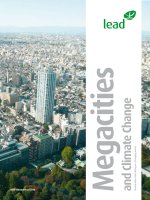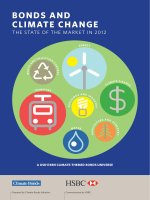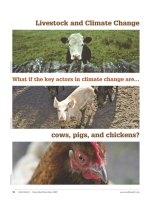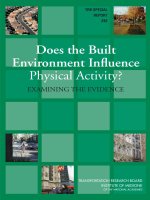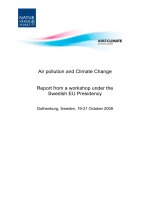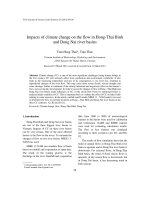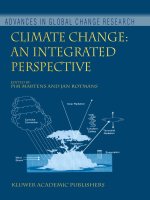Migration, Environment and Climate Change: ASSESSING THE EVIDENCE docx
Bạn đang xem bản rút gọn của tài liệu. Xem và tải ngay bản đầy đủ của tài liệu tại đây (2.27 MB, 448 trang )
Migration,
Environment and
Climate Change:
ASSESSING THE EVIDENCE
17 route des Morillons, 1211 Geneva 19, Switzerland
Tel: +41.22.717 91 11 | Fax: +41.22.798 61 50
E-mail: | Internet: hp://www.iom.int
MIGRATION, ENVIRONMENT AND CLIMATE CHANGE: ASSESSING THE EVIDENCE
US$ 78.00
The opinions expressed in the report are those of the authors and do not
necessarily reect the views of the Internaonal Organizaon for Migraon (IOM).
The designaons employed and the presentaon of material throughout the
report do not imply the expression of any opinion whatsoever on the part of IOM
concerning the legal status of any country, territory, city or area, or of its authories,
or concerning its froners or boundaries.
IOM is commied to the principle that humane and orderly migraon benets
migrants and society. As an intergovernmental organizaon, IOM acts with its
partners in the internaonal community to: assist in meeng the operaonal
challenges of migraon; advance understanding of migraon issues; encourage
social and economic development through migraon; and uphold the human
dignity and well-being of migrants.
This publicaon was prepared in collaboraon with the United Naons University
Instute for Environment and Human Security (UNU-EHS) with the generous
nancial support of the Rockefeller Foundaon. In parcular we would like to thank
Claudia Juech from the Rockefeller Foundaon for her constant support.
Edited by: Frank Laczko and Chrisne Aghazarm
Copy Editor: Olga Sheean
Publisher: Internaonal Organizaon for Migraon
17 route des Morillons
1211 Geneva 19
Switzerland
Tel: +41.22.717 91 11
Fax: +41.22.798 61 50
E-mail:
Internet: hp://www.iom.int
______________
ISBN 978-92-9068-454-1
© 2009 Internaonal Organizaon for Migraon (IOM)
______________
All rights reserved. No part of this publicaon may be reproduced, stored in
a retrieval system, or transmied in any form or by any means, electronic,
mechanical, photocopying, recording, or otherwise without the prior wrien
permission of the publisher.
92_08
Migration,
Environment and
Climate Change:
ASSESSING THE EVIDENCE
Edited by
Frank Laczko and Chrisne Aghazarm
UNITED NATIONS
UNIVERSITY
UNU-EH S
Institute for Environment
and Human Security
in collaboraon with
with the nancial support of
3
Migraon, Environment and Climate Change: Assessing the Evidence
Contents
Foreword by William Lacy Swing 5
Chapter I: Introducon and Overview: Enhancing
the knowledge base 7
1. Introducon 9
2. Contextualizing the migraon, environment and
climate change debate 13
3. The state of current knowledge and gaps:
A summary of key ndings 17
4. Recommendaons for further policy-oriented research 29
5. Concluding remarks 35
6. References 37
Chapter II: Challenges and approaches to measuring the
migraon–environment nexus 41
1. Seng the scene 43
2. Climate change impact, adaptaon and
vulnerability (CCIAV) 51
3. Migraon and the environment 69
4. Issues of uncertainty and data requirements 77
5. Discussion and research priories 83
6. References 91
7. Appendix 1 (from Migraon DRC, 2008) 109
8. Appendix 2 (from the Mexican Migraon Project (MMP)
website: mmp.opr.princeton.edu) 111
Chapter III: Collecng data on the migraon–environment nexus 113
1. Introducon 115
2. The current state of knowledge 119
3. Data collecon 139
4. Case study on Petén, Guatemala: adding
quesons to an exisng survey 157
5. Ecuador case study 161
6. Conclusions and recommendaons 171
7. References 177
Chapter IV: Researching environmental change and migraon:
evaluaon of EACH-FOR methodology and applicaon
in 23 case studies worldwide 197
1. Introducon 199
2. EACH-FOR methodology 203
3. Field experiences: Viet Nam, Mozambique and Niger 213
4. Recommendaons for future environment–migraon
research 229
4
Migraon, Environment and Climate Change: Assessing the Evidence
5. Conclusions 233
6. References 235
7. Appendix 241
Chapter V: Migraon and natural disasters 245
1. Introducon 247
2. Migraon and natural disaster stascs 255
3. Migratory movements out of disaster-aected areas 265
4. Migraon into disaster-aected areas 287
5. Conclusions and recommendaons 293
6. References 301
Chapter VI: Migraon and slow-onset disasters:
desercaon and drought 319
1. Introducon 321
2. The changing climate and human vulnerability 323
3. Drought, desercaon and migraon 325
4. Other policy challenges: migraon and climate adaptaon 333
5. Conclusion 339
6. References 343
Chapter VII: Managing environmentally induced migraon 353
1. Introducon 355
2. Life cycle for managing environmentally induced migraon 359
3. Strategies in developing countries to manage
environmental migraon 361
4. References 381
Chapter VIII: The role of legal and normave frameworks for the
protecon of environmentally displaced people 385
1. Introducon 387
2. The case for developing the capacity of rights-based norms
and instruments of protecon to support the needs of
environmental migrants 391
3. The role of exisng legal and normave frameworks in
aording eecve protecon to environmental migrants
and the scope for enhancing these frameworks 405
4. The extent to which legal and normave frameworks can
support the capacity of local and regional governance and
civil society structures to implement adaptaon and
resilience strategies 423
5. Research needs and priories 425
6. Conclusions: the supremacy of a rights-based approach 433
7. References 435
5
Migraon, Environment and Climate Change: Assessing the Evidence
Foreword by William Lacy Swing
The consequences of climate change on migraon present humanity
with an unprecedented challenge. The numbers of storms, droughts
and oods have increased threefold over the last 30 years with
devastang aects on vulnerable communies, parcularly in the
developing world. In 2008, 20 million persons have been displaced by
extreme weather events, compared to 4.6 million internally displaced
by conict and violence over the same period. How many people will
be aected by climate change by 2050? Forecasts vary from 25 million
to 1 billion people with a gure of 200 million being the most widely
cited esmate.
Extreme environmental events such as cyclones, hurricanes, tsunamis
and tornadoes tend to capture the media headlines, but it is gradual
changes in the environment that are likely to have a much greater
impact on the movement people in the future. For example, over the
last 30 years, twice as many people have been aected by droughts as
by storms (1.6 billion compared with approximately 718 million).
It is important, however, not to view migraon as simply the failure
of communies to adapt to climate change. Migraon has always
been one of the ways in which people have chosen to adapt to
changing environments. Migraon can also help those le behind in
environmentally degraded areas. Studies in Côte d’Ivoire, for example,
have shown that migrants who moved from Burkina Faso regularly sent
home remiances which were invested in schools and hospitals and in
water and irrigaon systems. Moreover, migrants are oen the rst to
provide assistance when natural disasters occur. Research in countries
such as El Salvador, Jamaica , Botswana and the Philippines has shown
that migrant remiances increase signicantly when disasters occur
providing essenal relief assistance to aected communies.
As the world’s leading migraon agency, the Internaonal Organizaon
for Migraon (IOM) endeavours to stay abreast of trends and issues
that impact the more than 212 million migrants worldwide. Since the
early 1990s, IOM has been acve in the area of migraon, climate
change and the environment, and has carried out programmes in more
than 40 countries from the Pacic Islands, to Lan America and on the
Asian and African connents. In many of these areas, we have assisted
those aected by hurricanes, severe ooding and drought.
6
Migraon, Environment and Climate Change: Assessing the Evidence
IOM’s programmac acon has constructed a solid foundaon of
rst-hand experiences and lessons learned that have energized the
Organizaon’s policy and research. We have sought to enhance our
knowledge base through research and publicaons that examine the
complex relaonship between migraon, climate change and the
environment. In doing so, we have been able to idenfy emerging
trends, raise awareness, and work towards innovave soluons that
are sensive to specic local condions.
The main purpose of this new book is to suggest concrete ways in
which the internaonal community can begin to address the huge gaps
in our knowledge relang to the likely impact of climate change on
migraon. The book does this by taking stock of the exisng evidence
on the eects of climate change and environmental degradaon on
migraon, providing a comprehensive overview of the ndings of
recent research studies. Throughout, our focus is centred on how
research can best inform policy and provide the evidence which
decision-makers will need in the future to plan for and respond to
environmentally induced migraon.
Addressing the unprecedented challenge before us requires
unprecedented partnership - collaboraon among internaonal
organizaons, civil society, the private sector, the academic world,
and governments. In preparing this new book , we hope to share our
experse with our partners and contribute to global dialogue and
eorts within the United Naons Framework Convenon on Climate
Change and beyond.
William Lacy Swing
Director General
Introduction and Overview:
Enhancing the knowledge base
Frank Laczko, Christine Aghazarm
1
1
Research and Publicaons Division, IOM, Geneva
Migraon, Environment and Climate Change: Assessing the Evidence
Enhancing the Knowledge Base
1. Introducon
Over the last few years there has been an upsurge of interest in the
likely impact of climate change on populaon movements. Esmates
have suggested that between 25 million to one billion people could be
displaced by climate change over the next 40 years. For the most part
these gures represent the number of people exposed to the risk of
climate change in certain parts of the world and do not take account of
the measures that could be taken to adapt to these changes. Although
experts have dismissed such gures as, at best, “guesswork” these
stascs have helped to focus policy makers’ aenon on the likely
implicaons of climate change on migraon.
Despite the lack of precise gures, there is now lile doubt that parts
of the earth are becoming less habitable due to factors such as climate
change, deterioraon of agricultural lands, desercaon, and water
polluon. The number of natural disasters has more than doubled
over the last two decades, and more than 20 million people were
displaced by sudden-onset climate-related natural disasters in 2008
(OCHA-IDMC, 2009). Further climate change, with global temperatures
expected to rise between 2 and 5 degrees cengrade by the end of
this century, could have a major impact on the movement of people.
Policy makers are therefore asking the research community and other
experts to provide them with guidance in regards to a number of key
quesons.
First, there is a call for beer data to answer quesons relang to the
likely scale and paern of movement such as, how many will migrate
due to environmental/climate change? Who will migrate? When and
where will they migrate; will new desnaons have to be found? Will
migraon be temporary or permanent, internal or internaonal? What
will be the consequences of migraon for the people who move, for
those le behind and for the places of desnaon? There is also a
concern to understand beer the here and now – how is environmental
change aecng migraon today and can we already idenfy especially
vulnerable populaons or regions?
10
Migraon, Environment and Climate Change: Assessing the Evidence
Enhancing the Knowledge Base
A second set of quesons concerns policy responses, and how policy
makers in countries of origin and desnaon should address these
challenges. Partly the response will depend on how we choose to frame
the policy challenge from the outset. There is a tendency at present
to frame the policy challenges in fairly negave terms with media
headlines oen suggesng that millions of people will be uprooted
and forced to seek protecon in Europe and North America. There
is also a tendency to focus on the inadequacy of policies and legal
frameworks to assist those displaced due to extreme environmental
events, with much less discussion of how migraon could help some
countries adapt to climate change.
“The literature on climate change and migraon is generally very
pessimisc about mobility arising from climate change. This creates a
starng point bias in thinking about policy responses, eschewing the
development of policies that seek to harness migraon as a strategy to
promote adaptaon to climate change…”
(Barne and Webber, 2009, p.19).
There has been an overwhelming tendency to focus on the negave
consequences of migraon for the environment, with fewer studies
exploring how migraon can be a coping or adaptaon strategy or how
migraon can relieve pressure on environmentally degraded areas.
The World Bank in a new report on Climate Change and Development
(2010) warns that there are risks in presenng the policy challenges
linked to environmental migraon in too negave terms:
“The negave portrayal of migraon can foster policies that seek to
reduce and control its incidence and do lile to address the needs of
those who migrate, when migraon may be the only opon for those
aected by climate hazards. Indeed, policies designed to restrict
migraon rarely succeed, are oen self-defeang, and increase the
costs to migrants and to communies of origin and desnaon.”
(World Bank, 2010, p. 25).
Developing an agenda for research which will help the internaonal
community understand these complex quesons and issues is going
to be extremely challenging. In the rst instance, it is useful to try to
take stock of the exisng evidence base and that is the key purpose of
this book. The book assesses the exisng body of evidence relang to
the likely impact of environmental and climate change on migraon,
and proposes several concrete ways in which to enhance the current
11
Migraon, Environment and Climate Change: Assessing the Evidence
Enhancing the Knowledge Base
knowledge base. In April 2008, IOM together with the UN University
Instute for the Environment and Human Security (UNU-EHS), the
Munich Re Foundaon and the UN Environment Programme (UNEP),
organized an expert workshop, “Research Workshop on Migraon
and the Environment: Developing a Global Agenda for Research”, in
Munich with nancial support from the Rockefeller Foundaon to
discuss how best to develop a global agenda for research on migraon,
climate change and the environment. Experts at this workshop all
recommended that a systemac review of exisng research should be
conducted prior to launching any major new studies. In parcular, it was
felt that such an assessment could help to frame the future research
agenda by highlighng gaps in current knowledge, outline conceptual
issues and highlight policy challenges. This book and the themes which
have been selected are the result of the recommendaons from the
Munich workshop.
This book focuses on seven key areas of research relang to the topic of
migraon, the environment and climate change, covering issues such
as data challenges, research methods, sudden environmental and slow-
onset events, and policy responses. The focus is not limited to climate
change as much of the research literature tends to focus on migraon
and the wider concept of environmental change. The book is mainly
focused on the impact of environmental/climate change on migraon
given the current policy interest in this issue, but it is recognized that
there is a considerable body of literature on the impact of migraon
and refugee movements, on the environment (see Bilsborrow Chapter
3 in this volume).
This book oers a selecve review of key research to date on the
topic of migraon, the environment and climate change within the
aforemenoned themes. It examines the exisng evidence with
respect to the ways in which changes in the environment and climate
change are aecng the movement of people and the types of policy
responses and protecon gaps which potenally exist. Furthermore,
it oers an overview of innovave approaches to measuring and
collecng data on the migraon and environment nexus.
The main aims of this rst chapter are to contextualize the migraon,
environment and climate change debate and to provide a summary
of the main ndings, knowledge gaps and key messages of the seven
chapters commissioned for this study. At the end of the chapter
we recommend a number of steps that could be taken to enhance
understanding of the linkages between changes in the environment
and the movement of people.
Migraon, Environment and Climate Change: Assessing the Evidence
2. Contextualizing the migraon, environment and
climate change debate
The migraon, environment and climate change nexus is a complex
one. By way of background and in order to contextualize the debate,
the following secon provides a brief overview of the issue in terms of
its “re-discovery”, the impacts of environmental and climate change on
human mobility, its development implicaons and how the issue links
to wider migraon and demographic trends.
A ‘re-discovered’ issue
The movement of people as a result of changes in the environment
is not a new phenomenon. People have been moving in response
to changes in their environment, oen seasonally, for centuries. For
nomadic peoples and pastoralists such movement is part of their
livelihood. However, it is only in the last 20 years or so that the
internaonal community has begun to slowly recognize the wider
linkages and implicaons that a changing climate and environment has
on human mobility.
As early as 1990, the Intergovernmental Panel on Climate Change (IPCC,
1990:20) warned that “the greatest single impact of climate change
could be on human migraon” – with millions of people displaced by
shoreline erosion, coastal ooding and severe drought. In addion, in
1992 IOM together with the Refugee Policy Group published a report
on “Migraon and Environment” in which it is stated:
“Large numbers of people are moving as a result of environmental
degradaon that has increased dramacally in recent years. The
number of such migrants could rise substanally as larger areas
of the earth become uninhabitable as a result of climate change.”
(IOM, 1992)
At the me the issue was framed within a wider security debate, but
the momentum did not last. Though it was a rst aempt to explicitly
Enhancing the Knowledge Base
14
Migraon, Environment and Climate Change: Assessing the Evidence
Enhancing the Knowledge Base
link migraon with environmental change, the topic of migraon
and the environment and its inter-linkages was largely ignored by
migraon experts and policy makers unl recently. Indeed, in the 2005
report of the Global Commission on Internaonal Migraon, there is
barely a menon of the topic. Part of the reason for the neglect may
be due to the fact that there has been lile consensus over the years
among researchers about whether or not environmental migraon is
a disnct form of migraon worthy of special study. There has been
lile consensus between researchers about the relaonship between
environmental change and migraon. As Shurke, 1993 points out, the
research literature on environmental migraon has tended to fall into
two broad categories (1) work done by “minimalists” who suggest
that the environment is only a contextual factor in migraon decisions
and (2) work done by “maximalists” who claim that the environment
directly causes people to be forced to move.
Due to several high level conferences, expert meengs, and new
research
2
published over the last few years, the issue has re-surfaced.
Experts have increasingly raised awareness of the linkages between
the environment and human mobility and the importance of unifying
these issues at all levels of policy dialogue and cooperaon – local,
regional, naonal and global.
Impacts of environmental and climate change on human mobility
Climate change, on its own, does not directly displace people or cause
them to move but it produces environmental eects and exacerbates
current vulnerabilies that make it dicult for people to survive where
they are. Climate change is expected to make the world hoer, rainfall
more intense, and result in more extreme weather events such as
droughts, storms and oods. These changes, in turn, will likely result
in further populaon movements. According to the UN Internaonal
Strategy for Disaster Reducon (UNISDR) – storms, oods and droughts –
have increased threefold over the past 30 years.
Extreme environmental events such as cyclones, hurricanes, tsunamis
and tornadoes tend to capture the media headlines, but gradual
2
UNFPA-IOM Expert Seminar on Migraon and the Environment, Bangkok 2007, IOM, UNU-EHS, UNEP and Munich
Re Foundaon Research Workshop on Migraon and the Environment, Munich 2008 and 2009; Environment, Forced
Migraon and Social Vulnerability (EFMSV) conference, Bonn 2008
15
Migraon, Environment and Climate Change: Assessing the Evidence
Enhancing the Knowledge Base
changes in the environment may have a much greater impact on the
movement of people in the future. Gradual environmental changes,
such as desercaon, coastal and soil erosion, tend to be less dramac
and therefore aract less aenon than natural disasters. However,
gradual and slow-onset changes in the environment tend to aect a
larger number of people and will connue to do so in the long term.
For example, during the period 1979-2008, 718 million people were
aected by storms compared to 1.6 billion people aected by droughts
(Internaonal Emergencies Disaster Database (EM-DAT), 2009).
As Susan Marn explains in Chapter 7 in this volume, climate change
could aect the movement of people in at least four dierent ways:
1. the intensicaon of natural disasters;
2. increased warming and drought that aects agricultural producon
and access to clean water;
3. rising sea levels make coastal areas uninhabitable and increase the
number of sinking island states. (44% of the world’s populaon
lives within 150 kilometers of the coast);
4. compeon over natural resources may lead to conict and in
turn displacement.
Some environmental changes, such as hurricanes and earthquakes,
occur with lile or no warning and require that people move quickly.
Others develop more slowly and may provide me for people to assess
their opons, leave in an orderly manner and even bring resources
with them. However, certain thresholds or “pping points” may be
reached, where there is lile choice le but to move. The extent to
which the environment, including climate change, is the primary driver
of migraon remains debatable for several reasons as discussed in
Secon 3 below. Migraon can also aect the environment in terms of
addional stress on already degraded lands and compeon for scarce
resources in both rural and urban sengs.
All regions are likely to experience some adverse eects of climate
change, but less developed regions are especially vulnerable because
a large share of their economies depend on climate-sensive sectors
and their adapve capacity is low due to low levels of human, nancial
and natural resources, as well as limited instuonal and technological
capability (IOM, 2008). Certain “hotspots” – regions or countries
already facing environmental, migraon and populaon pressures -
are expected to worsen in the coming years such as the sinking small
16
Migraon, Environment and Climate Change: Assessing the Evidence
Enhancing the Knowledge Base
island states, like Tuvalu and the Maldives and in delta regions (inter-
alia the Mekong, Inner Niger Delta and the Ganges Delta), and regions
already facing severe drought and desercaon such as the Sahel
region.
Development implicaons: migraon as adaptaon
The potenal benets of migraon for development are now widely
recognized at the highest levels beginning with the High Level Dialogue
on Migraon and Development in 2006, and connuing with the
recognion of the impact of remiances on countries of origin and on
individual migrants and their families, the role of Diasporas and the
work being carried out to integrate migraon into poverty reducon
strategy papers (PRSPs).
However, as menoned earlier, discussions of migraon triggered
by environmental changes, usually see migraon as the result of a
failure to adapt to the environment, rather than as a possible way of
enhancing adaptaon to climate change. Migraon may itself be one
of several adaptaon strategies and a coping strategy, for example
in the Sahel region in mes of drought or as a response to regular
ooding in the oodplains of India. The IOM Colombian Temporary
and Circular Labour Migraon programme, for example, provides an
opportunity for families aected by natural disasters to nd temporary
work abroad (IOM 2009).
The concept of “adaptaon” has gained internaonal aenon
within the discourse on climate change, notably with the context of
the Copenhagen Process and beyond. There is increasing recognion
that migraon has a role to play within this discourse (see Marn
Chapter 7 in this volume; IOM 2007, 2008; World Bank 2010; UNDP
2009). Migraon when a planned and voluntary coping mechanism
can serve as a social safety net for loss of income for example through
the sending of remiances, and could potenally serve to alleviate
pressure on already degraded lands.
Therefore, bringing together migraon, development, climate change
and the environment policy perspecves is a priority and challenge for
policy makers if the issue is to be addressed holiscally.
3. The state of current knowledge and gaps: A
summary of key ndings
The complexity of the migraon and environment nexus as described
above, requires not only contextualizing the debate, but also a coherent
framing of the issues which surround it. The following sub-secons,
while providing a summary of the key ndings and knowledge gaps
idened throughout the book, also serve to do just that – idenfy and
frame the main issues of relevance for policy makers and researchers
alike. They are grouped as follows: (i) conceptualizing the relaonship
between climate change, the environment and migraon, (ii) data and
methodological challenges and approaches, (iii) current migraon
trends in response to sudden and slow-onset disasters, and (iv) policy
responses and legal frameworks.
(i) Conceptualizing the relaonship between climate change, the
environment and migraon
The mul-causal nature of migraon represents a challenge
in idenfying environmental factors as the primary driver
of migraon. The voluntary/forced migraon debate also
raises addional issues where “Populaon mobility is
probably best viewed as being arranged along a connuum
ranging from totally voluntary migraon,…to totally forced
migraon” where reality is somewhere in between (Hugo,
1996). How those who migrate for environmental reasons
are dened has implicaons for both legal frameworks and
research purposes.
Although many experts accept that environmental degradaon and
climate change are factors which can impact on the decision to migrate,
the conceptualizaon of these factors as a primary cause of migraon
or forced displacement has been quesoned (Black, 2001). Given the
mul-causal nature of migraon, which can result from a combinaon
of various “push” and “pull” factors that can be inter-alia economic,
social, polical, establishing a direct causal link is a challenge. The key
is assessing the extent to which the environment or climate change
Enhancing the Knowledge Base
17
Migraon, Environment and Climate Change: Assessing the Evidence
18
Migraon, Environment and Climate Change: Assessing the Evidence
Enhancing the Knowledge Base
is the primary driver or simply one of many drivers of migraon (see
Kniveton Chapter 2, Warner et al. Chapter 4 in this volume).
Whether movements in relaon to environmental or climate change
are forced or voluntary is also the subject of much debate. In some
situaons, such as natural disasters, people may have lile choice but
to move. However, migraon paerns beyond the immediate move
may shi between forced and voluntary. In other situaons where
environmental change is gradual, movement is more likely to be
voluntary and linked to other economic, social and polical factors.
Drawing a clear line between voluntary and forced movements is not
always straighorward. Therefore, it is perhaps more useful, instead,
to think in terms of a connuum:
“Populaon mobility is probably best viewed as being arranged along a
connuum ranging from totally voluntary migraon,… to totally forced
migraon, very few decisions are enrely forced or voluntary.”
(Hugo, 1996)
(i) Denions
Denions are crucial in two ways 1) in guiding the policies of
governments and internaonal agencies in regards to how to respond
to populaon movements; and 2) in the generaon of stascs which
also depends on how those who migrate for environmental reasons
are dened (see ii.a. below).
Terms, such as “climate change refugee” or “environmental refugee”
are widely used in the media but these terms are a misnomer under
internaonal law and risk undermining the very precise legal denion
of a refugee and the protecon regime which exists (see Zeer Chaper
8 in this volume). Moreover, as the bulk of environmental migraon
tends to occur within countries rather than between countries it makes
more sense to talk of internally displaced persons than refugees, a
term which is dened in relaon to cross-border movement. Others
have argued that “the term ‘environmental refugee’ is simplisc, one-
sided and misleading. It implies a mono-causality which very rarely
exists in pracce” (Castles, 2002, p.8).
The term “environmental refugee” was rst popularized by Lester
Brown of WorldWatch Instute in the 1970s and further by El-Hinnawi
in the early 1990’s. The term “environmental refugees” has been used
19
Migraon, Environment and Climate Change: Assessing the Evidence
Enhancing the Knowledge Base
to describe the whole category of people who migrate because of
environmental factors. This broad denion, while evoking an image
that has brought public aenon to the issue, is not suciently precise
to describe all the various types of movements which may be linked to
environmental factors.
The terminology and denional issues have been taken up by various
experts and internaonal agencies. Notably, the Inter-Agency Standing
Commiee (IASC) Working Group on Migraon/Displacement and
Climate Change has devised a typology which summarizes the nature
of movement, the aected persons and the protecon framework
under which those who are moving may be granted protecon (2008).
In the absence of an internaonally agreed denion, IOM developed
a working denion in 2007 which denes “environmental migrants”
as follows:
“Environmental migrants are persons or groups of persons who, for
compelling reasons of sudden or progressive change in the environment
that adversely aects their lives or living condions, are obliged to
leave their habitual homes, or choose to do so, either temporarily or
permanently, and who move either within their country or abroad.”
The purpose of this denion is to try to encompass populaon
movement or displacement, whether it be temporary or permanent,
internal or cross-border, and regardless of whether it is voluntary or
forced, or due to sudden or gradual environmental change.
(ii) Research on migraon, environment and climate change: data and
methodological challenges and approaches
A persistent lack of data is one of the primary challenges to
measuring the migraon and environment nexus, while data
collecon on migraon and the environment represents a
challenge in itself. A range of methodologies exist which
can be ulized and enhanced for research purposes.
The topic of environmental migraon has oen been studied within
separate elds in the natural and social sciences or within a sub-set
of the larger eld of environment studies. How the subject has been
framed impacts on both data collecon as well as the methodological
approaches used. Though migraon theory does historically take into
account environmental indicators, it is only recently that it has received
renewed aenon.
20
Migraon, Environment and Climate Change: Assessing the Evidence
Enhancing the Knowledge Base
(ii.a) Data collecon challenges
As menoned earlier, there are many esmates of the total number of
people who will be displaced (incidentally gures usually do not refer to
numbers expected to migrate) due to climate change. These gures are
oen called into queson (see Kniveton et al. Chapter 2 in this volume)
because they rely on crude populaon esmates and they assume
that populaons will permanently leave areas aected by climate
change. Probably the most reliable data are the stascs relang to
the impact of natural disasters on populaon movements. The ndings
of a joint report by the United Naons Oce for the Coordinaon of
Humanitarian Aairs (OCHA), the Internal Displacement Monitoring
Centre (IDMC) and the Norwegian Refugee Council (NRC) show that
at least 36 million people were displaced by sudden onset natural
disasters that occurred in 2008. More than half of the displacement –
20 million persons – was esmated to be climate-related.
There are several factors which make it dicult to measure current
levels of environmental migraon and to predict the likely scale of
future follows. It is extremely dicult to predict the impact of climate
change and climate modelling techniques to date have not yet begun
to account adequately for the impact of individual choice, the potenal
for internaonal acon and the variability of future emissions and
meteorological scenarios (see Kniveton et al. Chapter 2, Bilsborrow
Chapter 3 and Leighton Chapter 6 in this volume; Brown, 2008).
The absence of an adequate denion to cover migrants aected by
climate and environmental change, discussed above, also presents a
challenge for stascs gathering. Disaggregang the role of climate
or other environmental change from other economic, polical and
social factors which drive migraon, while also taking into account
migrants’ percepon and behaviour in relaon to such change, is a
dicult task. Furthermore, challenges exist as well in how terms and
concepts such as ‘environment’, ‘disasters’, ‘adaptaon’, ‘vulnerability’,
etc. are dened and ulized, thereby adding to the complexity of data
collecon (see Warner et. al Chapter 4, Naik Chapter 5 in this volume).
There is a basic lack of migraon data available, especially in developing
countries which are likely to be most vulnerable to climate change.
Many countries sll do not include basic quesons about migraon in
their censuses. Even in the current 2010 census round, many important
countries sll do not ask where people were born – including Japan,
Mexico, Korea, the Philippines, and Egypt. Roughly a third of countries
do not ask about previous residence in another country (Center for
21
Migraon, Environment and Climate Change: Assessing the Evidence
Enhancing the Knowledge Base
Global Development (CGD), 2009). There is a lack of reliable surveys, in
addion to the census, for many key parts of the world. Though small
scale local case studies provide a valuable context specic analysis of
a certain area and/or environmental phenomenon, they need to be
expanded and “scaled up.”
Moreover, few social sciensts who focus on migraon (relying on
data from censuses and household surveys) have been engaged in
data collecon or research on the environment. Similarly, relavely
few of those who focus on the environment, whether social or natural
sciensts, work on migraon. However, as the interest in climate
change and its impacts on populaon movement has increased at the
global level, more interdisciplinary cooperaon has begun.
Finally, lack of data collecon and research capacity, especially in
developing countries most vulnerable to environmental changes,
remains a serious issue. In its recent research strategy paper, the
United Kingdom’s Department for Internaonal Development (DFID),
highlights the current lack of research capacity in developing countries
(2008). There are only 48 researchers for every million Africans living
south of the Sahara compared with nearly 3,000 for every million people
in OECD countries Therefore, building the capacies of researchers in
these regions is a crucial component of addressing the research and
data challenge.
(ii.b) Methodological approaches
Data collecon challenges are not easily separated from methodological
ones and inherently impact upon the results of the approach ulized.
What data is being collected, both migraon (ie. length of residence,
characteriscs of migrants and non-migrants, household composion,
remiances) and environmental (i.e. land use, energy use, land
degradaon, drought and ooding) are crucial in order to understand
the linkages between the two.
Several methodological approaches do exist which are promising
and would benet from further enhancement and inter-disciplinary
cooperaon. These range in aim and scope from inter-alia assessments
such as impact, vulnerability and adaptaon assessments, climate
modelling such as agent based modelling, the use of remote sensing
data to measure environmental variables and household and
community based surveys (for more detail on methods see Kniveton
et al. Chapter 2, Bilsborrow Chapter 3 and Warner, et al. Chapter 4 in
this volume).
22
Migraon, Environment and Climate Change: Assessing the Evidence
Enhancing the Knowledge Base
Addional methods include modelling techniques such as agent-based
modelling, not oen used in climate studies, which aims to capture
the decision making behaviour of individuals while also being able
to predict such behaviour as well as the interplay between these
decisions and larger scale outcomes. Such mul-agent approaches
oer a dierent perspecve to tradional economic models, which
consider individuals as raonal actors making decisions to maximize
their well-being with unlimited cognive resources. Instead agent-
based models underline individuals do not necessarily make decisions
in isolaon, have social interacons and their percepons may
be biased or incomplete. Other modelling techniques created to
integrate and correlate socio-economic data and biophysical datasets
could potenally be used within a migraon and environment context
bearing in mind the caveats, in parcular to migraon data, referred
to previously.
Surveys, both household and community, present yet another set of
approaches to measuring migraon in relaon to the environment. For
household surveys, specic modules can be integrated which include
quesons to idenfy migrants from the household, work acvity of
the migrant prior to migraon, reasons for migraon, work at the last
desnaon and remiances received. For the environment these would
cover issues related to land use, producon, degradaon, change in
weather, etc. Remote sensing from a series of satellite images can also
be used to analyse land changes over me and scale. At the community
level, surveys are most relevant in rural areas where boundaries are
most easily dened. Bilsborrow specically highlights two case studies
using these methods in Chapter 3: Guatemala, where quesons were
added to a Demographic and Health Survey (DHS) on migraon and
the environment highlighng the value of adding quesons to exisng
surveys. The second case in Ecuador used an innovave mulple
source and method approach integrang samples of households and
communies through surveys, together with satellite imagery over a
period of eight years.
The EACH-FOR project, as analysed by Warner, et al. is another example
of a project which aempted to isolate the environment as the primary
variable or driver in migraon through a series of small scale surveys
in 23 countries. Though the samples were not representave on a
naonal or regional scale, they did idenfy several research challenges
such as dening “the environment” issues of temporal and geographic
scales as well as migrants’ percepons of their environment and risk
which are all important consideraons in undertaking future work
in this eld. The EACH-FOR project helps to lay the groundwork for
further larger scale studies.
23
Migraon, Environment and Climate Change: Assessing the Evidence
Enhancing the Knowledge Base
(iii) Current migraon trends in response to sudden and slow-onset
disasters
Migraon which does occur in response to both sudden and slow
on-set environmental events exhibits varied characteriscs which
can be organized according to the following spectrum: voluntary –
forced; temporary – permanent; internal – internaonal; vulnerability
– resilience (see Naik Chapter 5 in this volume). Vulnerability and
adapve capacity are further inuenced by several factors such as
inter-alia gender, age and ethnic background which may in turn inform
decisions to migrate at the societal, household and/or individual level.
Migraon related to both sudden and slow-onset events are likely
to be predominantly internal, with movements being rural-rural and
rural-urban, and in terms of internaonal migraon generally to the
nearest border – the Pacic small island developing States represent
a parcular case where “statelessness” could be an issue. Longer
distance internaonal migraon requires nancial resources and social
networks which facilitate such a move. Such movements which do
occur do so mainly along already exisng migraon paerns.
With regard to sudden onset disasters, a clear nding is that migraon
post-disaster takes on various paerns based on the nature, intensity
and duraon of the disaster, the group aected and the locaon
(see Naik Chapter 5 in this volume for a more detailed discussion of
migraon post sudden onset natural disasters; see also Warner et
al. Chapter 4 in this volume for addional case examples). Though
data does exist on the incidence of natural disasters and the overall
numbers of those aected, data is lacking on the paern and scale of
migraon aer disasters occur.
Most of the populaon movement following disasters tends to be
short-distance and temporary in nature. Though the inial movement
may be on the forced side of the spectrum, subsequent movements
may also be more voluntary. Though the numbers of natural disasters
is increasing, there has not been a signicant increase in internaonal
migraon for the reasons explained previously. Even in the case of the
Asian Tsunami in 2004, there was lile out-migraon to neighbouring
countries in Asia; most of those aected by the Tsunami were displaced
within their own countries (see Naik Chapter 5 in this volume).
Exposure to risk and adapve capacity are also crical factors which
inuence migraon decision making processes. While a disaster may

